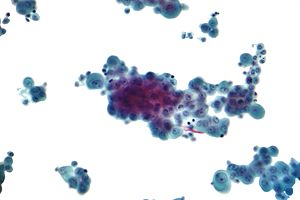Mesothelioma,
Mesothelioma rare form of cancer,
Mesothelioma, more precisely malignant mesothelioma, is a rare form of cancer that develops from the protective lining that covers many of the body's internal organs, the mesothelium. It is usually caused by exposure to asbestos.
Its most common site is the pleura (outer lining of the lungs and internal chest wall), but it may also occur in the peritoneum (the lining of the abdominal cavity), the heart, the pericardium (a sac that surrounds the
Mesothelioma | |
|---|---|
Classification and external resources | |
Left sided mesothelioma with mediastinal node enlargement : CT scan. | |
ICD-10 | |
ICD-9 | |
ICD-O: | M9050/3-9055 |
OMIM | |
DiseasesDB | |
MedlinePlus | |
eMedicine | |
MeSH | |
heart) or tunica vaginalis.
Most people who develop mesothelioma have worked on jobs where they inhaled asbestos particles, or they have been exposed to asbestos dust and fiber in other ways. It has also been suggested that washing the clothes of a family member who worked with asbestos can put a person at risk for developing mesothelioma. Unlike lung cancer, there is no association between mesothelioma and smoking, but smoking greatly increases the risk of other asbestos-induced cancers. Compensation via asbestos funds or lawsuits is an important issue in mesothelioma (see asbestos and the law).
Asbestosis,
Asbestosis facts,
| Asbestosis | |
|---|---|
| Classification and external resources | |
 Micrograph of asbestosis showing the characteristic ferruginous bodies and markedinterstitial fibrosis (or scarring). H&E stain. | |
| ICD-10 | J61. |
| ICD-9 | 501 |
| DiseasesDB | 928 |
| MedlinePlus | 000118 |
| eMedicine | med/171 radio/52 |
| MeSH | D001195 |
Asbestosis is a chronic inflammatory and fibrotic medical condition affecting the parenchymal tissue of the lungs caused by the inhalation and retention of asbestos fibers. It usually occurs after high intensity and/or long-term exposure to asbestos (particularly in those individuals working on the production or end-use of products containing asbestos) and is therefore regarded as an occupational lung disease. People with extensive occupational exposure to the mining, manufacturing, handling or removal of asbestos are at risk of developing asbestosis. Sufferers may experience severe dyspnea (shortness of breath) and are at an increased risk for certain malignancies, including lung cancer and mesothelioma. Asbestosis specifically refers to interstitial (parenchymal) fibrosis from asbestos, and not pleural fibrosis or plaquing.
Signs and symptoms
Peritoneal mesothelioma,
Peritoneal mesothelioma is the name given to the cancer that attacks the lining of the abdomen. This type of cancer affects the lining that protects the contents of the abdomen and which also provides a lubricating fluid to enable the organs to move and work properly.
The peritoneum is made of two parts, the visceral and parietal peritoneum. The visceral peritoneum covers the internal organs and makes up most of the outer layer of the intestinal tract. Covering the abdominal cavity is the parietal peritone,.......Serous carcinoma,
Ovarian serous carcinoma,?
Serous carcinoma is a type of epithelial ovarian cancer, which is the most common kind of ovarian cancer. According to the American Cancer Society, ovarian cancer accounts for six percent of all cancers among women. The five-year survival rate for women with advanced ovarian cancer is 15 to 20 percent. If the disease is found at an early stage, survival approaches 90 percent.,
Most likely to have ovarian serous carcinoma,?
Women with a personal or family history of breast, ovarian, endometrial, prostate, or colon cancer have the highest risk of having ovarian serous carcinoma, especially if their mother or sister had ovarian cancer. Other risk factors include age; use of high-dose estrogen for long periods without progesterone; or uninterrupted ovulation due to infertility, no pregnancies, or no use of birth control. Jewish women and women inheriting a defect in the BRCA1 or BRCA2 gene also have an increa,.........Mesothelioma Applied Research Foundation,
Mesothelioma Applied
| Mesothelioma Applied Research Foundation | |
|---|---|
 Logo | |
| Motto | Believe in a cure |
| Formation | 1999 |
| Type | NPO |
| Legal status | Foundation |
| Headquarters | |
| Location | 3944 State Street, Suite 340 Santa Barbara, CA 93105 805.563.8400 805.563.8411 (fax) |
| Region served | United States |
| Interim Executive Director | Kathy Wiedemer |
| Medical Liaison | Mary Hesdorffer |
| Outreach Director | Maja Belamaric |
| Website | Mesothelioma Applied Research Foundation |
Research Facts,
The Mesothelioma Applied Research Foundation (Meso Foundation, formerly MARF) is a non-profit organization that funds mesothelioma research, provides services to patients, educates the public, and advocates in Washington, DC for governmental funding for mesothelioma research. The organization's mission is to eradicate mesothelioma, a cancer caused by exposure to asbestos, as a life-ending disease,.......
Current Medicinal Chemistry development in Mesothelioma cancer,
Current Medicinal Chemistry by C. Belli and colleagues has analyzed angiogenic factors in the development of malignant mesothelioma cancer.
Angiogenesis is the process of new blood vessel growth from pre-existing vessels. The researchers believe that a better understanding of molecular mechanisms and pathways involved in angiogenesis is the basis for developing new drugs against malignant mesothelioma. Such drugs that target these pathways may impact the proliferation and survival of tumor cells.





No comments:
Post a Comment